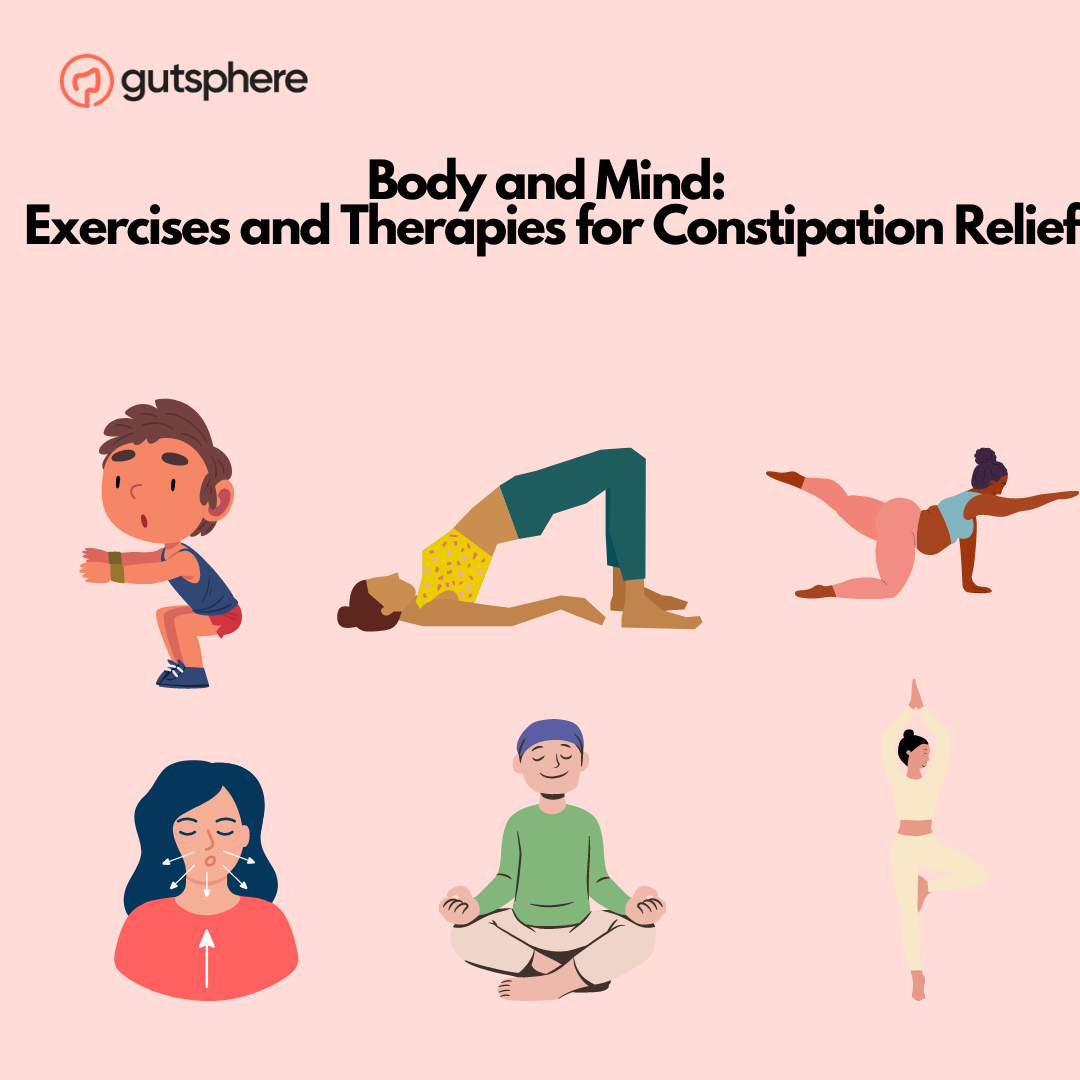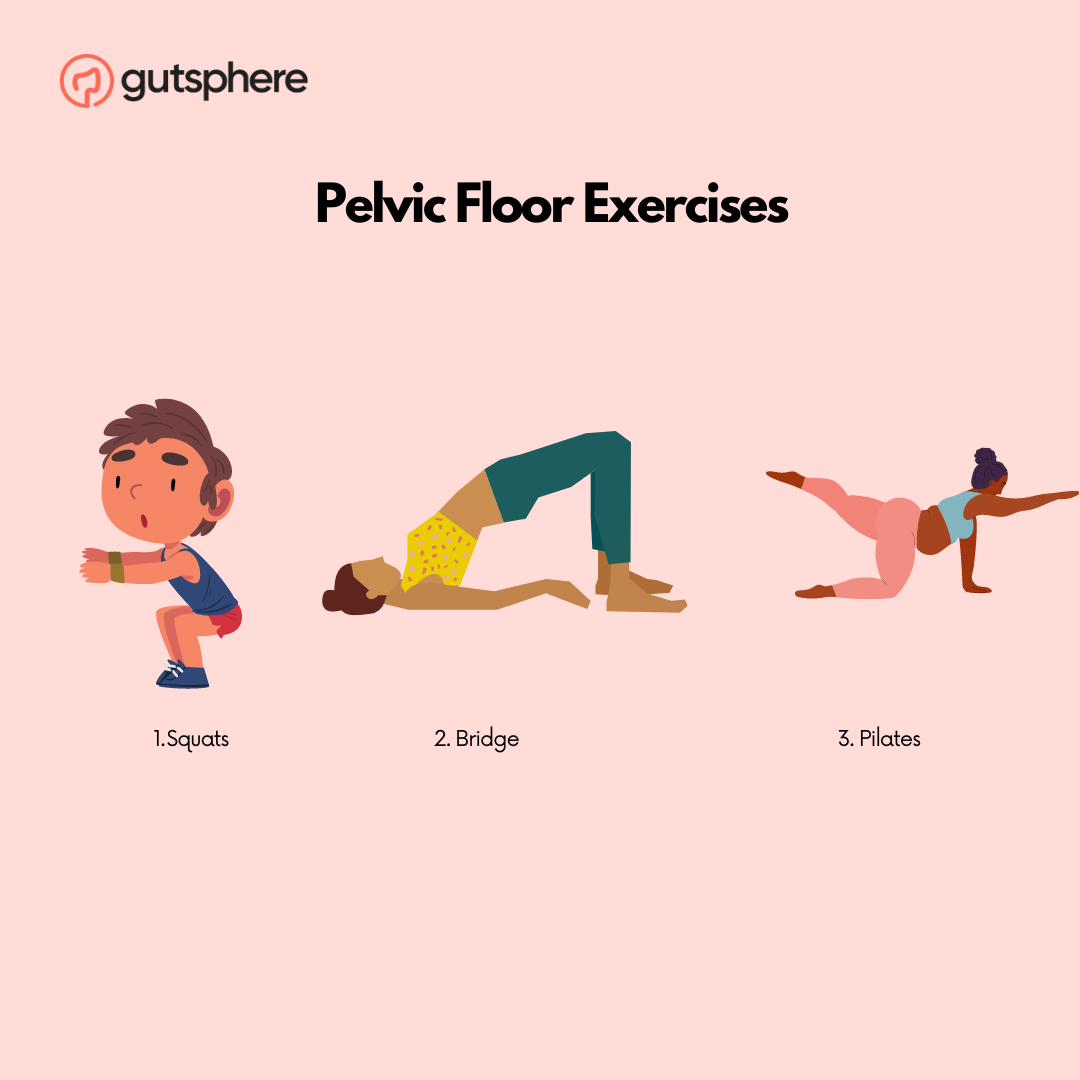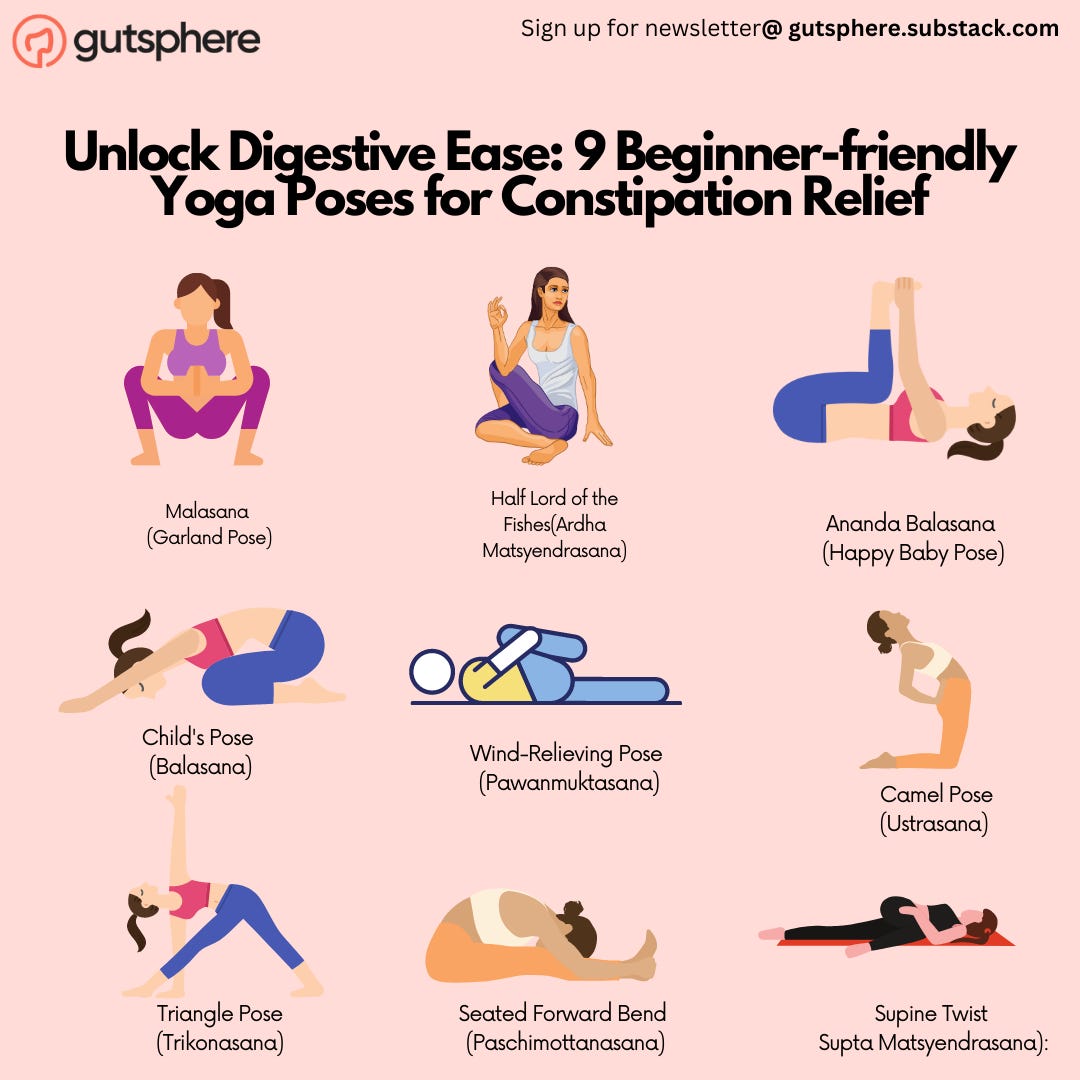Body and Mind: Exercises and Therapies for Constipation Relief(Part 4/5)
Strengthening Your Core: Pelvic Floor Exercises for Constipation Relief The Power of Biofeedback Therapy in Managing Constipation Mind-Body Exercises for Constipation Relief: Breathing, Meditation,
Welcome Back Friends!
Brace yourselves as we dive into an assortment of exercises and therapies that can provide relief from constipation. Let's strengthen our bodies and relax our minds as we work towards improving our digestive health.
Pelvic Floor Exercises
Pelvic floor exercises, also known as Kegels, are essential for maintaining and improving pelvic floor function. They can be especially beneficial for people experiencing bowel movement issues, urinary incontinence, or for women after childbirth. Here are a few exercises that can help strengthen our pelvic floor muscles:
Kegel Exercises
Steps:
Identify our pelvic floor muscles. These are the muscles we would use if we were trying to stop urinating mid-stream or hold in gas.
Contract these muscles and hold for a count of five, then relax for a count of five.
Repeat this exercise 10 times. Aim for at least three sets of 10 repetitions a day.
As we get more comfortable, try to hold the contraction for longer (up to 10 seconds) and increase the number of repetitions.
Squats
Squats engage our core and offer a great workout for our pelvic floor muscles.
Steps:
Stand with our feet shoulder-width apart, toes pointing slightly outward.
Bend at our knees and hips, lowering your body as if we were about to sit on a chair. Keep our chest upright and your knees over our toes.
Lower until our thighs are parallel to the floor.
Push back up to the starting position, focusing on pushing through your heels.
Repeat 10 times for 3 sets.
Bridges
Bridges are a great exercise for strengthening your glutes, but they also work our pelvic floor.Steps:
Lie on our back with our knees bent, feet flat on the floor, and arms by our sides.
Push through your heels to lift our hips off the floor, creating a straight line from our shoulders to our knees.
As you lift, engage our pelvic floor muscles and hold for a few seconds.
Lower our body back to the starting position.
Repeat 10 times for 3 sets.
Pilates
Pilates exercises are great for strengthening your core, including our pelvic floor muscles. The 'tabletop' exercise is a good starting point.Steps:
Lie on our back with your knees bent and our feet flat on the floor.
Raise one leg so our knee and hip are bent at 90-degree angles. Our shin should be parallel to the floor. This is the tabletop position.
Maintain this position, engage our core and pelvic floor muscles as we slowly lower our other foot to the floor and bring it back up.
Repeat 10 times on each leg.
Remember to breathe naturally throughout these exercises and do not strain or push down while performing them. Consult with a healthcare provider or a physiotherapist if you have any concerns or if you're unsure about performing the exercises correctly. These exercises may not be suitable for everyone, especially those with certain health conditions. Always seek professional advice before starting a new exercise regimen.
Biofeedback Therapy
This one is not zero cost. It requires an expert instructor. Biofeedback therapy involves training the mind to control bodily functions. It can be used to help manage constipation by teaching individuals how to relax and contract muscles in the rectum and anus.
Steps:
You'll begin by having a sensor inserted into your rectum, which is connected to a monitor. This sensor will measure muscle tension.
Your therapist will guide you through exercises designed to help you understand how to contract and relax your pelvic muscles.
As you perform these exercises, the sensor will provide feedback on the monitor, showing you how your muscles are responding.
Over time, you'll learn how to control these muscles more effectively, helping to manage your constipation.
Precautions:
Biofeedback therapy should always be performed under the supervision of a trained healthcare professional.
It may not be suitable for everyone, so it’s essential to discuss this option with your healthcare provider before starting.
Mind Body Exercises for constipation relief
The human body is a complex network of interconnected systems, and the health of one can significantly impact the others. This connection is particularly evident when considering the relationship between our mental state and physical health. Stress, anxiety, and emotional tension can manifest in various physical ailments, one of which is constipation. The digestive system is highly sensitive to our emotional and mental states, and stress can lead to a slowing of the digestive process, which in turn can cause constipation.
Conversely, a calm and relaxed state of mind can promote a healthy and regular digestive system. This is where mind-body exercises come into play. These exercises, rooted in ancient practices, aim to harmonize the mind and body, reduce stress, and promote overall health and wellbeing. They can be a powerful tool in managing and preventing constipation.
We will explore three key mind-body exercises that can help relieve constipation: Breathing exercises, Meditation, and Yoga.
Breathing Exercises:
Breathing is an automatic function of our body that we often take for granted. However, mindful breathing exercises can be a simple yet powerful way to relax our body and mind, reducing stress and encouraging a healthy digestive process.
We have done an extensive edition on Breathing Exercise. Please check here.
Meditation:
This is a practice of focusing our mind on a particular object, thought, or activity. Regular meditation can significantly reduce stress and anxiety, promote emotional health, enhance self-awareness, and improve overall well being, all of which can contribute to a healthier digestive system.
We have done an extensive edition on Meditation. Please check here.
Yoga:
Yoga is a physical, mental, and spiritual practice that originated in ancient India. It includes a series of postures, breathing exercises, and meditation techniques that work together to promote physical strength, flexibility, and mental clarity. Certain yoga poses can stimulate the digestive system and encourage bowel movements, providing relief from constipation.
We will do an extensive series on Yoga. For now, below are the poses that can help in improving digestion and relieving constipation.
Malasana (Garland Pose):
This deep squatting pose helps in the overall digestion process.Steps:
Let's start by standing with our feet about shoulder-width apart.
Bend our knees and lower our hips, coming into a squat.
Separate our thighs slightly wider than our torso and lean our body forward.
With our hands in prayer position, press our elbows against the inner knees. This will help us stay balanced.
Hold this pose for about 5-10 breaths.
Ananda Balasana (Happy Baby Pose):
This pose helps stretch and soothe the back while also promoting relaxation.Steps:
Let's start by lying flat on our back.
Bring our knees towards our chest.
Take hold of the outer edges of our feet with our hands, keeping our arms on the outside of our legs.
Gently use our upper body strength to equally press both knees to the floor below our armpits. Try not to tense our shoulders or chest, but keep everything relaxed.
Hold for about 5-10 breaths.
Seated Easy Twist:
Twisting poses can stimulate digestion and help with the elimination process.Steps:
Let's start in a comfortable seated position.
Cross our right foot over the outside of our left thigh, keeping our left leg bent towards us.
Place our right hand on the floor behind us for support, and raise our left arm.
As we exhale, gently twist our body to the right, hooking our left elbow over our right thigh. Look over our right shoulder.
Stay in this pose for about 5-10 breaths, then release and repeat on the other side.
Crow Walks:
This isn't a traditional yoga pose, but a series of movements that mimic the squatting position of a crow walking. This can help stimulate digestion.Steps:
Let's start in the Malasana (Garland Pose) with our hands on the floor in front of us.
We then take small steps forward, remaining in the squatting position.
Keep moving forward for about 10-20 steps.
Wind-Relieving Pose (Pawanmuktasana): This pose helps us relieve bloating and gas, and it stimulates the passage of waste through the digestive tract. To perform this pose, we lie flat on our back. We bend our right knee and bring it towards our chest. We hold our shin with both hands and gently pull our knee closer to our chest. We hold this for a few breaths, then release and repeat with the other leg.
Child's Pose (Balasana): This restful pose helps us relax and can also stimulate digestion. To get into this pose, we sit back on our heels with our knees hip-width apart. We lower our torso between our knees and reach our arms forward along the ground. We rest our forehead on the mat and hold this for several breaths.
Triangle Pose (Trikonasana): This pose can stimulate the bowels and improve digestion. We stand tall, then step our feet about three feet apart. We turn our right foot outward and our left foot slightly inward. We reach our right hand down to our ankle, shin, or the floor (depending on our flexibility), and extend our left arm toward the ceiling. We look up at our left hand and hold this for several breaths before switching sides.
Seated Forward Bend (Paschimottanasana): This pose can massage the abdominal organs, aiding digestion. We sit with our legs extended in front of us. We reach our arms overhead, then hinge at our hips to fold forward. We reach for our shins, ankles, or feet, and hold this for several breaths.
Supine Twist (Supta Matsyendrasana): This pose can stimulate the digestive organs, aiding in the passage of waste through the body. We lie on our back, bring our knees to our chest, then let both knees fall over to the right side. We extend our arms out to the sides and turn our head to the left, creating a twisting motion. We hold this for a few breaths, then repeat on the other side.
Remember, it's always important for us to listen to our bodies during these exercises. If we feel any discomfort, we should ease out of the pose. It's also a good idea to consult with a healthcare provider or a yoga teacher if we're new to yoga or if we have any health concerns.
Conclusion:
We've explored how exercises and therapies can help us manage constipation. It's impressive how much control we can have over our bodies with the right mindset and routine.
Next: Part 5
As we approach the final part of our journey, we'll delve into the wisdom of traditional remedies and advanced techniques to manage constipation. Stay tuned for a fascinating fusion of the old and the new!
Request
Share
Our sincere request to you is to share the newsletter with your friends, family, and community so that they can benefit from the content. Also it will help us grow the newsletter, and eventually, as we release more content, digital tools, and more we will enable people around the world to live chronic disease free.
Subscribe
If you haven’t already subscribed then our sincere request, please subscribe.
Feedback
Also, please give us feedback so that we can improve the content. And if there are any topics that you want us to cover please send us your questions and topics. Furthermore, if you try any of the things we provided information please share your experience with us.
Thank You
gutsphere Team
Disclaimer
Please note that the information provided in this newsletter is for informational purposes only and should not be considered as a substitute for professional medical advice, diagnosis, or treatment. If you have any concerns or questions about our health, please consult with a licensed healthcare professional. The information contained in this newsletter is not intended to diagnose, treat, cure, or prevent any disease. The publisher and authors of this newsletter assume no responsibility for any adverse effects that may result from the use of the information contained herein.




